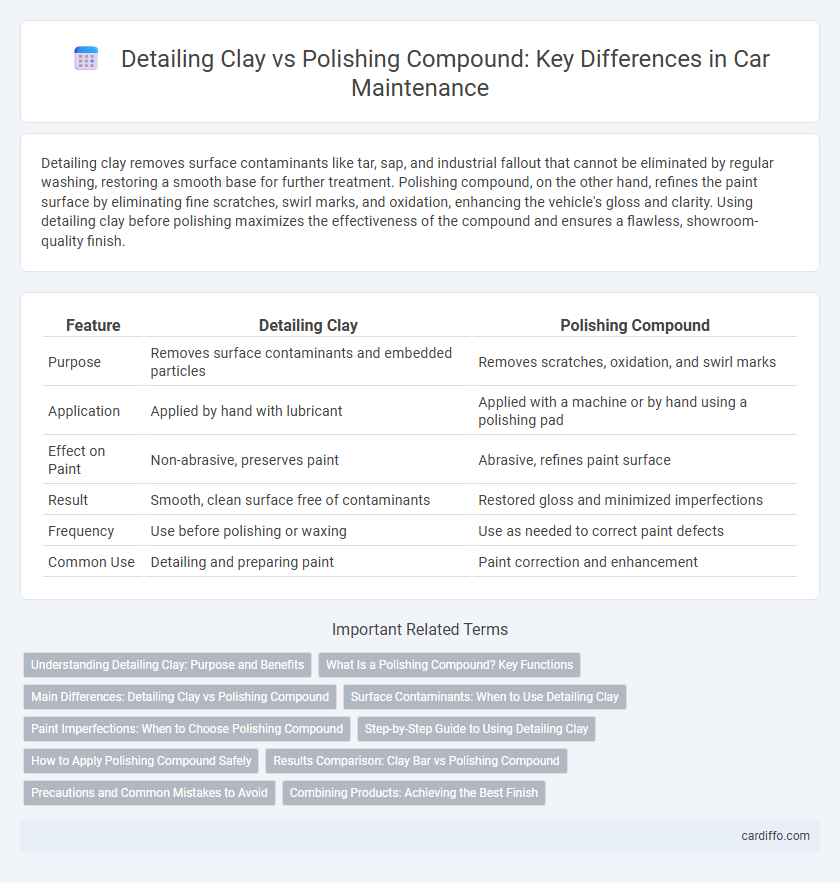Detailing clay removes surface contaminants like tar, sap, and industrial fallout that cannot be eliminated by regular washing, restoring a smooth base for further treatment. Polishing compound, on the other hand, refines the paint surface by eliminating fine scratches, swirl marks, and oxidation, enhancing the vehicle's gloss and clarity. Using detailing clay before polishing maximizes the effectiveness of the compound and ensures a flawless, showroom-quality finish.
Table of Comparison
| Feature | Detailing Clay | Polishing Compound |
|---|---|---|
| Purpose | Removes surface contaminants and embedded particles | Removes scratches, oxidation, and swirl marks |
| Application | Applied by hand with lubricant | Applied with a machine or by hand using a polishing pad |
| Effect on Paint | Non-abrasive, preserves paint | Abrasive, refines paint surface |
| Result | Smooth, clean surface free of contaminants | Restored gloss and minimized imperfections |
| Frequency | Use before polishing or waxing | Use as needed to correct paint defects |
| Common Use | Detailing and preparing paint | Paint correction and enhancement |
Understanding Detailing Clay: Purpose and Benefits
Detailing clay is designed to remove bonded contaminants like industrial fallout, brake dust, and tree sap from a vehicle's paint surface, which traditional washing cannot eliminate. Its fine abrasiveness restores smoothness by lifting impurities without damaging the clear coat, enhancing paint clarity and gloss. Using detailing clay before polishing ensures a cleaner surface, allowing polishing compounds to work more effectively and achieve a flawless finish.
What Is a Polishing Compound? Key Functions
A polishing compound is an abrasive substance used in automotive maintenance to remove fine scratches, oxidation, and surface imperfections from paint, restoring smoothness and shine. It contains fine abrasive particles designed to refine the surface by cutting through oxidized layers and minor blemishes without damaging the clear coat. This compound plays a key role in preparing the paint surface for waxing or sealing, ensuring a glossy, even finish that enhances the vehicle's appearance.
Main Differences: Detailing Clay vs Polishing Compound
Detailing clay removes surface contaminants like tar, sap, and industrial fallout by physically lifting particles without affecting the paint's clear coat, while polishing compound is abrasive, designed to smooth out minor scratches, oxidation, and swirl marks by removing a thin layer of clear coat. Detailing clay is used prior to polishing to prepare the surface for better compound adhesion, whereas polishing compound is applied to restore paint clarity and shine. The key difference lies in their function: clay cleans contaminants off the paint surface, polishing compound corrects and enhances paint imperfections.
Surface Contaminants: When to Use Detailing Clay
Detailing clay effectively removes surface contaminants such as industrial fallout, brake dust, and overspray that cannot be eliminated through regular washing, restoring a smooth paint finish. It is ideal for use before polishing compounds to prepare the surface by eliminating embedded particles that cause roughness and imperfections. Polishing compounds, however, are designed to correct paint defects like scratches and oxidation rather than removing contaminants embedded in the clear coat.
Paint Imperfections: When to Choose Polishing Compound
Polishing compound is ideal for addressing deeper paint imperfections such as scratches, oxidation, and swirl marks that cannot be removed by detailing clay alone. While detailing clay effectively eliminates surface contaminants like tar and overspray, it does not correct paint texture or restore gloss. Choosing a polishing compound helps to refine the clear coat, enhancing paint clarity and achieving a smoother, more polished finish.
Step-by-Step Guide to Using Detailing Clay
Detailing clay effectively removes embedded contaminants from your vehicle's paint, creating a smooth surface before polishing or waxing. Begin by thoroughly washing and drying the vehicle, then lubricate the surface with a clay lubricant or diluted car wash soap. Gently glide the clay bar across the paint in straight motions, frequently folding the clay to expose a clean surface, and continue until the paint feels smooth to the touch.
How to Apply Polishing Compound Safely
When applying polishing compound, use a soft, clean microfiber cloth or a foam applicator pad to work the compound into the surface gently, ensuring even coverage. Apply the compound in small sections with light to moderate pressure, avoiding aggressive scrubbing that can damage the paint or clear coat. Always follow up with a proper wash to remove residue and inspect the surface for any signs of over-polishing or damage.
Results Comparison: Clay Bar vs Polishing Compound
Clay bars effectively remove bonded surface contaminants such as tar, industrial fallout, and overspray, restoring a smooth texture without altering the paint's clear coat. Polishing compounds, composed of abrasive particles, refine the paint surface by eliminating fine scratches, swirl marks, and oxidation, enhancing gloss and depth. While clay bars prepare the surface for further treatments, polishing compounds deliver visible improvements in paint clarity and shine.
Precautions and Common Mistakes to Avoid
When using detailing clay, avoid applying it on dry surfaces as this can cause scratching and reduce effectiveness; always lubricate the area with a clay lubricant or quick detailer to prevent marring. Polishing compound requires caution to prevent removing too much clear coat, so use moderate pressure and a proper foam pad, ensuring you test on a small section first to avoid swirl marks or hazing. Common mistakes include using detailing clay too aggressively or skipping the lubrication step, and applying polishing compound without proper technique or overusing it, which can damage the paint finish.
Combining Products: Achieving the Best Finish
Combining detailing clay with polishing compound enhances surface preparation and finish quality by first removing contaminants and then refining paint texture. Detailing clay effectively eliminates embedded debris and overspray, ensuring the polishing compound can work on a smooth, clean surface for optimal gloss and swirl removal. This two-step process maximizes paint clarity and durability, delivering a professional-grade finish.
Detailing clay vs Polishing compound Infographic

 cardiffo.com
cardiffo.com